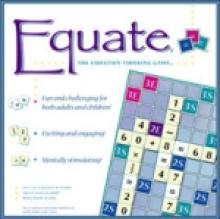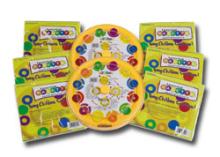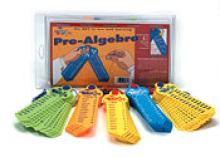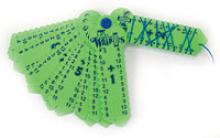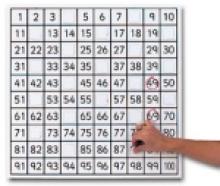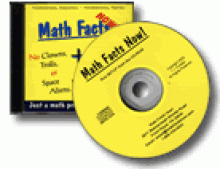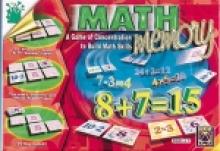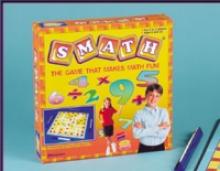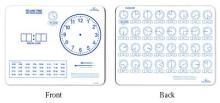Math Manipulative
Equate: The Equation Thinking Game
Similar in format to the word game Scrabble�, Equate allows players to place equations on a board while gaining points based upon the types of numbers and operations used. (For example, a fraction is worth more points than a whole number and a division symbol is worth more points than an addition symbol. Don't worry - the point value is marked on each tile.) Players may add on to existing equations provided that both sides of the equation are still equal.
We found this to be a fun and challenging game for upper grade school through adult. Add on sets can be purchased for younger grades or for advanced Math (the advanced set also includes negative numbers and exponents). Even with the basic set, level of play can be quite challenging considering equations involving multiplication and division of fractions and order of operation. Rules could easily be adjusted to accomodate players with varying skill levels.
Learning Palette Mathematics
Learning Wrap-Ups, plastic palette and colored discs with self-correcting card sets (This review is based on use of the first and third grade sets).
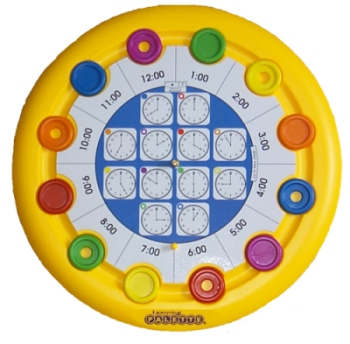 This clever learning tool for young children features an almost 12 inch diameter "palette" which holds a double-sided learning card and 12 different colored discs. A clear plastic lid is included. I have been very impressed with how these palettes hold up under a lot of use (and occasional abuse from babies and toddlers). Each card has pictorial equations or problems on one side. The child matches the correct color/shape disc with the answer he chooses. When finished placing all twelve discs, he can turn the card over and correct the answers himself.
This clever learning tool for young children features an almost 12 inch diameter "palette" which holds a double-sided learning card and 12 different colored discs. A clear plastic lid is included. I have been very impressed with how these palettes hold up under a lot of use (and occasional abuse from babies and toddlers). Each card has pictorial equations or problems on one side. The child matches the correct color/shape disc with the answer he chooses. When finished placing all twelve discs, he can turn the card over and correct the answers himself.
Cards are purchased in sets of 12 (a total of 144 problems since there are 12 problems per page). Math sets are available for first through third grade. There are six card sets available for each of these three grades:
Three sets of Numeration Cards: The numeration sets cover all kinds of basic math operations with an appropriate level of challenge and content.
One set of Algebra Concept Cards: First grade algebra card "challenges" include recognizing missing numbers and finding missing shapes. The third grade cards involve solving for the unknown in addition subtraction, multiplication and division.
One set of Geometry and Measurement Cards: First grade cards cover shape names, volume, calendars, telling time and reading thermometers. The third grade set covers includes problems regarding perimeter, area, geometric forms and terms, simple graphing and units of measurement.
One set of Probability and Statistics Cards: These cards cover topics like "more and less likely" and tallying in the first grade set. The third grade set provides practice in the relationship between fractions and probability, determining the likelihood of an event and using the data from charts to draw conclusions.
I am very impressed with the level of challenge and variety of topics covered at appropriate age-levels (they meet the National Council of Teachers of Mathematics standards). We have found these particularly nice because they offer mental stimulation while taking a break from writing-skills (which can be very taxing on children in the early grades). For example, we used these with my third grade son last year as a supplement to MCP 3rd Grade Math. Some days he would just do Learning Palettes for his Math assignment. (In addition, I had him spend some time doing mazes and other fine-motor skill building activities.) He didn't do every page of the MCP book - instead I let him test out of some of the chapters (he had to achieve a very good score in order to skip the chapter - naturally we had to discuss some concepts as they came up on the Learning Palettes as well).
Investing in the entire line of Learning Palettes can be rather expensive. The Palette itself is about $15 and each card set is $10 (you can buy grade-level groupings of six sets for a little less). I found this investment to be quite worthwhile since the product is non-consumable (and quite sturdy). The material is very straightforward and well thought-out.
Learning Wrap-Ups for Pre-Algebra: Introductory Kit
Each of five sets in this kit have 10 plastic key-shaped cards that fan-out at a pivot point. A sturdy string attached to the pivot point is pulled through a hole in the card. The student then wraps the string from the first problem to the answer, around the back of the card to the next problem, etc. After completing the card, you turn the card over. If the string matches with the lines on the back, all the answers are correct.
The five sets drill the following materials:
Addition & Subtraction of Positive and Negative Numbers Sample problem: (-9)-(-2)=t
Multiplication & Division of Positive and Negative Numbers Sample problem: (-7)x(-12)=p
Solving for the Unknown (Working with Variables) Sample problem: (-42)-z=(-3)
Understanding Algebraic Expressions Sample problem: Given x=7, evaluate 8x-7
Mental Math, Prime Factors, Perfect Squares, Square Roots, Formulas for Area, Perimeter and Volume Sample problem: Find the square root of 289
Our family has enjoyed the Learning Wrap-ups as a nice way to drill facts. I'm impressed with the thought that has gone into the equations. My 6th grade daughter has found this set a little challenging (more appropriate for 7th and 8th grade), but a welcome change from her textbook.
Learning Wrap-Ups: Basic Math Introductory Kit
These colorful key-shaped plastic flash cards allow students to practice basic Math skills by wrapping a string around the ribbed edges of each card to identify the correct answer. (Cards are attached together on a pivot point in groupings of 10 cards organized by operation.) The cards are cleverly self-correcting - when the child finishes each card, they simply flip it over; when all answers are correct, the string will match the diagram on the back of the card. The basic operations sets are simple equations where you match the equation to the correct answer. For the fractions set, you are matching equivalent fractions - pictures to fractions, pictures to pictures and fractions to fractions - plus a few simple equations which involve adding and subtracting fractions.
We have found this to be a great way for our children to practice their basic math facts. They are colorful and appealing and offer a welcome change from regular book-work.
Please note when ordering this product that there are many varieties of this product – some including CDs or workbooks, or even large classroom size sets. The set reviewed here retails for about $45-$50 (in 2024) and contains 5 flash-card sets – Addition, Subtraction, Multiplication, Division and Fractions.
Also see the Learning Wrap Ups website for more details and an animated demo.
Another reviewer (Suchi) notes: One of my sons is a highly visual learner, so much so that he managed to memorize the patterns that the strings made on the fronts of the keys. He could "do" the wrap-ups incredibly fast, but was not actually learning the facts. Parents may want to occasionally check the student's math facts in some other way to ensure that they are really getting learning. The wrap-ups did work well for my other children.
Magnetic Hundreds Board
This 23" x 23" laminated poster is made by Nasco.
I have used homemade hundreds charts for years - they've been a great help for Math in preschool, kindergarten and early grade school. I was so excited when I saw this item in a catalog because it is advertised as a "double-sided wipe-off white board with sheet magnet-receptive surfaces." I immediately dreamed up all sorts of fun things my little ones could do on this board with skip-counting, covering numbers, etc.
I was immediately disappointed in the quality of the board. It really is more of a thick poster than a board. It seems to be made of two cardstock poster-sized sheets with a thin metallic sheet in between. The three sheets are laminated together with a rather thin laminate (I honestly couldn't tell at first if this was the packaging to be removed - it wasn't!). Nevertheless, I decided to give it a try and hung it on the wall. My first grade daughter very happily proceeded to draw x's over all of the even numbers (this was fun!). We discovered soon afterwards that our markers (Expo2 dry erase markers) would not erase from this board. We tried two different kinds of dry-erasers, a special dry-erase board spray and finally windex and paper towels.
I want to make clear that Customer Service at Nasco was very easy to deal with in getting my money refunded. But this is a product I recommend avoiding.
Math Facts Now!
Advertised as "No Clowns, Trolls or Space Aliens...Just a math program that works!", this program really is just a simple way of drilling math operations. A simple menu allows you to choose your operation, number of problems to solve and how much time to do it in. You can even write in a reward that will be offered when the child achieves at a certain level!
My nine-year-old son really loves this program. He says he likes being able to choose the operation and doing some of his Math without having to write everything out. He basically thinks it's fun time on the computer, but I know that he's learning his math facts too.
Version 2.0 for Windows 2000, ME, XP, Vista and 7.
Website: https://tablefacts.com/
Math Memory
Creative Toys, 1997, 140 study cardboard cards in a standard game box
This is a fun and well-made math version of the classic Memory game. Instead of finding matching pictures, children match equations with answers. (Equation cards and answer cards look different on the backs so you can select one of each.) The answer cards have a sample equation for each operation printed in the corners. Equations are color-coded according to operation so you can easily sort out ones that you aren't currently focusing on (it's also a little difficult to use all the cards at once - there are so many!)
Smath: The Game that Makes Math Fun
Smath is a very similar game to Equate. It comes with a game board, 4 plastic tile racks and plastic tiles with a bag for the tiles. Tiles: 6 each of numbers 0-12, 10 blanks, 36 equal signs, 9 each of addition, subtraction, multiplication and division signs, and 12 clear parentheses that stack over another tile when used. There are no fractions or decimal points. Each player draws 10 tiles per turn. Game play is similar to Scrabble, but equals sign and parentheses tiles are kept separate and can be used as needed. This prevents game play from stalling.
Telling Time Dry Erase Board
Nasco, 11" x 14" sturdy wooden dry-erase board
This is a sturdy and elegant little dry-erase white board for young children learning to tell time. Parents can use this for demonstrating principles of telling time or it can be enjoyed by young children for independent learning.
The front sports a large clock face complete with numbers but no hour or minute hands (these can be drawn in with a dry-erase marker). There is also a blank spot for a digital clock reading so that children can write in those numbers while practicing telling time. The bottom bar marks 32 different times that the child can practice.
The back has 32 small clocks marked with different times. The child can write the correct time underneath each clock.
What a great and reasonably priced product. We have two so that a younger sibling can participate too.

